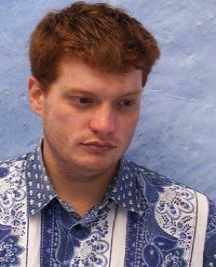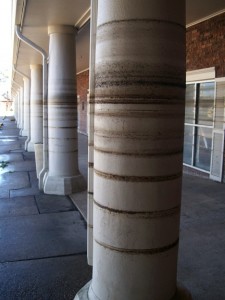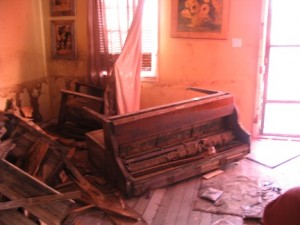
Composer Christopher Trapani talks about his new work, Waterlines, written for Talea and funded by an American Composers Forum Jerome Foundation commissioning grant.
You were born and raised in New Orleans and it is clear that the rich sonic tapestry of blues and jazz is an important element that you draw from in your own work. Do you find that having had an academic or you could say euro-centric compositional education is difficult to reconcile with the vernacular traditions? Is it a very conscious decision to meld your disparate interests or has it been an organic process of inquiry?
I’ve found that what inspires and fascinates me the most — in cities, in art, in food — is cultures converging to produce unexpected results. That’s how we got Andalucía, chicken tikka masala, and Graceland. Certainly New Orleans fits into that tradition, uniting many more strands than most people realize — including my Irish and Italian relatives who landed there at the end of the 19th century, back when New Orleans was the country’s second largest point of entry.
So the melting pot aesthetic comes naturally to me. I like it when one passion, one part of my life, bleeds into another. That kind of synthesis is a crucial element of my work, as it is for many artists — but it has to be organic, not contrived.
The storm brought up a lot of emotions about home and identity, what’s unique to a tradition and what is universal, and the cycle is really born out of a reflection on the various poetic and musical meanings of home. To the Carter family, home is heaven, a future hope. To Ramblin’ Thomas (whose incomparable “Poor Boy Blues” is set in the third song), home’s a distant memory. To Charley Patton, it’s the tonic chord, the resonant open strings of his guitar. To Gérard Grisey it’s a lush, consonant harmonic spectrum. All these conceptions get tossed in the pot.
Since you left New Orleans, you’ve been many places: Harvard, at the Royal College of Music in London, in Paris, Istanbul and at Columbia University here in New York. How has this physical displacement and experience of such diverse cultures affected your work and your own identity? Does it deepen your desire to maintain a strong connection in your work to the American vernacular?
Well, I have to say first off that I don’t always engage with American folk music or jazz; that’s only a small percentage of my work. But I do like for my music to be heard in a wide context, to draw from and make allusion to a variety of styles: Ottoman classical makam, Darmstadt grit, West African balafons, obscure Ninth Ward rock…
There’s probably some truth to the old cliché that moving abroad (and worse, to Paris) makes you more aware of your “Americanism,” that the distance gives a new sense of perspective. It was here anywhere that I first discovered Greil Marcus’ Invisible Republic (now published as The Old, Weird America) and Harry Smith’s folk music anthology, both of which got me thinking about parallels between early American music and the spectral music I was hearing at IRCAM and the Cité de la Musique — another current I found myself immersed in for the first time.
The sounds and phrases of blues and country records run throughout Waterlines. But while it may be the most immediately apparent layer of influence, it’s only the surface. A careful listener will hear the spell of spectral music — an oscillation between consonance and noise, microtonal inflections that mirror natural resonance — as well as snippets of Romantic lieder, marching band rhythms, and the eclectic spirit of George Crumb.
Waterlines consists of five blues songs with lyrics taken from the Carter Family and Bessie Smith, amongst others. The lyrics are poignant. They’re about the loss or displacement of home and of water and floods, with titles like, “Can’t Feel at Home,” and “Wild Water Blues.” On the score of this work you have two dates: 2005 and 2012. 2005 was the year that Hurricane Katrina devastated the southeastern United States and although 2012 is the date of the completion of your work, there is a poignancy and relevance in the wake of Super Storm Sandy. Can you say a few things about this? Did you already begin to compose this piece in the wake of Katrina? How were you personally affected by it?
Katrina was a complete shock. Devastating, life-changing. My father’s house was washed away, my childhood home got ten feet of water, but the worst effects were less tangible: morale was shaken, the cultural landscape of my hometown was changed forever. No one knew what would happen going forward, whether an entire set of traditions and a unique way of life might just disappear. I was already living in Paris when the storm hit, but to say I felt it strongly would be an understatement.
I wrote the first song, “Can’t Feel at Home,” in the immediate aftermath, in the fall of 2005. You’ll hear it nearly exactly as it was finished then, before I returned home for the first time after the storm in December 2005. I’d already gotten the idea of creating a cycle around the songs of the 1927 flood, and had started collecting and organizing texts in my mind, but I stopped composing there, returning to the piece only last summer.
I think it’s fair to say that it haunted me for seven years, while I tried to find the circumstances to bring what I considered a very personal and important project to life — so I’m extremely grateful to the Talea Ensemble and Anthony Cheung in particular for giving me this tremendous opportunity.
Can you talk about why you chose to write these blues songs? Are they still, “the blues” after your treatment of them?
Katrina got me reading (John Barry’s Rising Tide, for starters) about the 1927 Mississippi River flood — one of the most destructive natural disasters in American history, one that complete reshaped Southern society and politics. As it happens, the flood coincided with the heyday of commercial recording in the South, a last burst of enterprise before the great depression that fortuitously left us with several great records chronicling the disaster.
Combing through compilations of blues lyrics and drawing on the research of Memphis musicologist David Evans, I sought out songs with some sort of parallel to Katrina, but always with the goal of fashioning a more abstract and timeless perspective. I tried to be very attentive to the forms of the texts I was treating, but also to mold them into something new.
Strictly speaking, the first is a strophic text, a hymn tune, and I use that as an analogue for the music: certain elements are constant, like a refrain — the steady strum of the dulcimer, the tonal roots of the harmony — whereas others are constantly evolving. The rest of the song texts consist of blues couplets, but these are used in a variety of ways. “Wild Water Blues” gives the first-person narrative, rushes through the couplets in an exaggerated lightning-speed account of the devastation. In fact only the fourth song, “Devil Sent the Rain Blues,” uses the classic AAB blues device of repeating the first line over a different harmony, subtly shifting the insinuation behind the words.

Waterlines showing water levels after the flood.
In borrowing the blues songs, did you transcribe the vocal lines from the recordings? How important is it for you to have a singer who understands the style, that is, not to sing with an, ‘over-trained’ voice?
It’s important to know that there are no actual transcriptions in Waterlines, only stylistic allusions. I did listen repeatedly to and try to absorb something essential from the records that lent texts to the cycle, but I don’t mimic them. I sometimes borrow larger gestural ideas: the way, for instance, Kokomo Arnold falls to the very bottom of his range at the end of each line of “Wild Water Blues,” or Charley Patton’s habit of snapping the low strings of the guitar against the fretboard.
As for the singer, it’s absolutely essential to have someone who sets the right tone and knows the traditions being referred to. Nine times out of ten, when a contemporary composition makes reference to some form of popular music, it’s tongue-in-cheek, a wink to the initiated. Here’s it’s the opposite: a dead-on honest, respectful, and thoroughly un-ironic treatment of the words. One of the reasons Waterlines took so long to premiere is a simple pragmatic one: I simply didn’t want to do it in France, where I hadn’t met a singer who I thought could pull off the English and the folk gestures. It’s such a pleasure to have the astonishing Daisy Press — the only person I know to have sung both Philippe Leroux and Neil Diamond — to collaborate with on the premiere.

Damage done to Trapani's family home after Hurricane Katrina.
The cycle begins with a solo Appalachian dulcimer, and later the singer accompanies herself on a retuned autoharp. How did you approach composing for the ensemble?
Well I wrote the “auxiliary strings” part — for one player who handles the Appalachian dulcimer, steel-stringed acoustic guitar, electric guitar, and a fretless double-stringed Turkish banjo called the cümbüş — with the intention of performing it myself. But I’m not exactly a virtuoso; quite the opposite. Instead, writing for myself allows me to focus on idiosyncratic details in the way I play. The just intonation autoharp is an instrument I first made for another piece (Westering) by retuning all the strings, then taking the chord-bars off, sanding them down, and recovering them with new felt patterns to make new chord shapes in just intonation (microtonal patterns that follow the natural harmonics of the overtone series).
But aside from my own unusual instruments and a few doublings (the clarinetist plays harmonica, the trumpet player picks up the sandpaper blocks), the line up is pretty standard: three winds, three strings, and a large percussion setup. The fifth song also features live electronics: samples of rain, pops from vinyl records, and percussion swishes and scrapes that provide a background constant layer of white noise — an idea either inspired by the pervasive noise of an old 78 RPM gramophone record or borrowed from the omnipresent maracas in Tristan Murail’s Ethers, though the context makes it hard to tell which.
Can you speak about the tuning?
Harmony in Waterlines runs the gamut from diatonic triads to wide microtonal chords. Microtones — that is, the pitches that fall between the tempered keys of the piano — are a common feature of the blues (as shadings of a tonal grid) and spectral technique (as partials of the overtone series), though clearly used rather differently in each case. Precision is important, and there are certain technical devices used to ensure a degree of accuracy in producing mictrotones on tempered instruments: retuning strings on the guitar and viola to match natural harmonics, tuning the flute down by a quarter-tone. Then for the voice and unfretted strings (including the slide guitar), which are obviously more capable of smaller inflections in pitch, microtones are written more freely.
Another parallel with spectral music comes to mind here: nuance of gesture is more important than pitch selection, which is in some sense pre-determined in both styles. A listener who hears just the notes of a blues scale in a Son House lick is missing the point, just as another who hears only shifting shades of consonance in Les Espaces Acoustiques is glossing over whole dimensions of the work. In Waterlines too, the focus is on the local level, small details of articulation and timbre.
Is there anything else you’d like the audience to know about Waterlines?
One question I hope Waterlines will raise is this: Is there any room left for the regional voice in American composition? In American art and literature, there seems to be a degree of recognition for non-centralized trends; Southern writers in particular are always said to have “a strong sense of place,” as Walker Percy always described it. But aside from a few radically disparate voices who unjustifiably get corralled together as “West Coast Experimentalists,” most American composers seem to end up in the Northeast, learning an amalgamated style and losing their accents in the process. Listening to their music, who could ever deduce that Nancarrow was from Arkansas, that Babbitt had been raised in Mississippi?
I was always shocked that the New York Philharmonic, commissioning a piece to commemorate the September 11 attacks, chose John Adams, one of the few composers synonymous with another major city. Was there no one in New York up to the task? On the other hand, you clearly don’t have to be up to your neck in water to have something to say about the storm. It’s a delicate line, but I do believe that re-valuing regional traditions — recognizing again that there are a wealth of perspectives and experiences within our own borders — can only enrich the new music landscape, and more importantly, might even be the key to recapturing some kind of immediate and gut-level connection with listeners.
SYNCHRONICITIES: NEW WORKS
PREMIERES BY LEWIS, TRAPANI, LEHMAN, CHEUNG
DECEMBER 14, 2012 8:00 PM
MANNES COLLEGE OF MUSIC
150 W 85TH STREET
NEW YORK, NY 10024
*FREE ADMISSION
